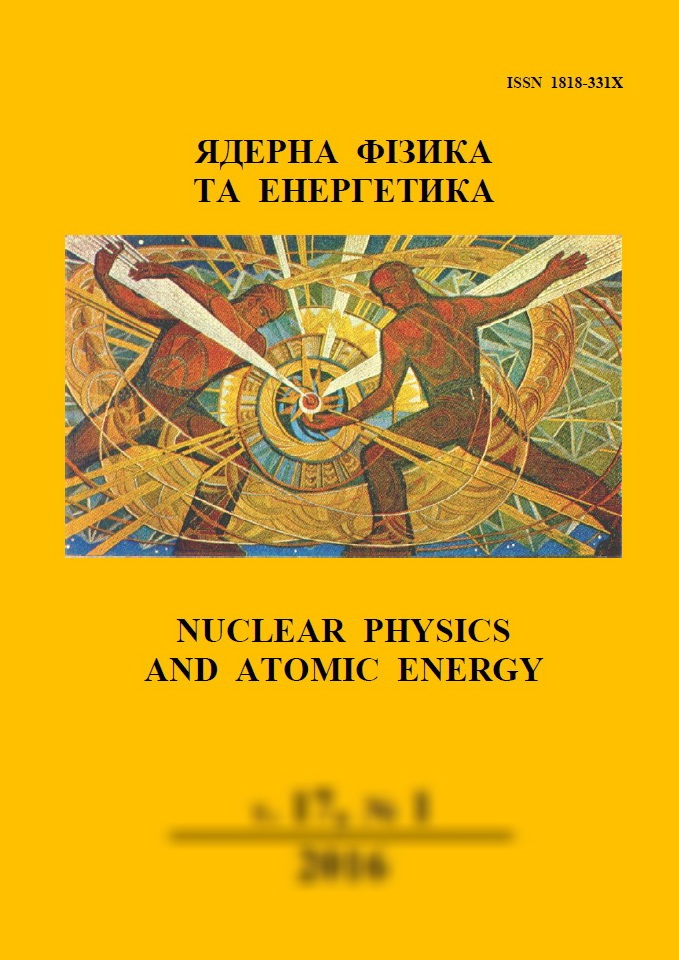 |
Ядерна фізика та енергетика
Nuclear Physics and Atomic Energy
ISSN:
1818-331X (Print), 2074-0565 (Online)
Publisher:
Institute for Nuclear Research of the National Academy of Sciences of Ukraine
Languages:
Ukrainian, English
Periodicity:
4 times per year
Open access peer reviewed journal
|
Nucl. Phys. At. Energy 2006, volume 7, issue 2, pages 75-81.
Section: Radiation Physics.
Received: 14.06.2006; Published online: 30.12.2006.
 Full text (ru)
Full text (ru)
https://doi.org/10.15407/jnpae2006.02.075
Application of the RELAP5-3D code in support of the NPP units safety analysis in Ukraine
A. M. Shkarupa, I. N. Kadenko
Kyiv Taras Shevchenko National University, Kyiv, Ukraine
Abstract:
Major part of calculations for transient and accident sequences for Ukraine NPP units has been performed with
computational codes based on point neutron kinetics and one dimensional thermohydraulics. Such an approach does not
allow modelling the mixing processes in reactor pressure vessel caused by coolant flow of separate loops. As a rule, the
limitations in modelling considered have been balanced by corresponding choosing of conservative initial and boundary
conditions. When three-dimensional thermohydraulics-neutronics coupled codes became available and local spatial effects started to be considered without significant simplifications there is a motivation and basis to reconsider the conservative results of earlier calculations, taking into account the operational experience of NPP units. This paper deals
with results of RELAP5-3D code analyses of the OECD/DOE/CEA V1000CT-2 benchmark and some computational
scenarios, for which the calculations have been performed under Rivne Unit 1 and Zaporizhzhya Unit 5 in-depth safety
analysis projects sponsored by the US DOE for NNEGC "ENERGOATOM". Based on the computational scenario for
accident “Main Steam Line Break” the influence of reactor vessel nodalization on modelling of coolant mixing and, as a
consequence, on results of the computational analysis is shown.
References:
1. The RELAP5-3D© Code Development Team. RELAP5-3D© Code Manual Volume I: Code Structure,
System Models, and Solution Methods. INEEL-EXT98-00834, Revision 2.3 (Adaho Falls, Idaho, April
2005).
2. HELIOS Methods - StudsvikTM Scandpower (April
2000).
3. Watson J., Ivanov K. Improved cross-section modeling methodology for coupled three-dimensional transient simulations. Annals of Nuclear Energy 29 (2002) 937.
https://doi.org/10.1016/S0306-4549(01)00085-8
4. Shkarupa A., Kadenko I., Malanich A. et al. Comparative RELAP5-3D analysis in support of the NPP
DBA analysis in Ukraine. Progress in Nuclear
Energy 48 (2006) 891.
https://doi.org/10.1016/j.pnucene.2006.06.001
5. Kolev N., Royer E., Bieder U. et al. VVER-1000
Coolant Transient Benchmark Volume II: Specifications of the RPV Coolant Mixing Problem. NEA/OECD - NEA/NSC/DOC (March 2004).
6. Moretti F., Melideo D., Terzuoli F., Shkarupa A.
Application of CFX-10 and RELAP5-3D to the simulation of coolant mixing phenomena in RPV of
VVER-1000 reactors. Proc. of the
OECD/DOE/CEA V1000-CT Fourth Workshop (Pisa, Italy, 24 - 25 April 2006).
7. Kolev N., Petrov N., Donov J. et al. VVER-1000
Coolant Transient Benchmark. PHASE 2 (V1000CT2) Vol. II: MSLB Problem - Final Specifications. NEA/OECD - NEA/NSC/DOC(2006)6 (February
2006).
